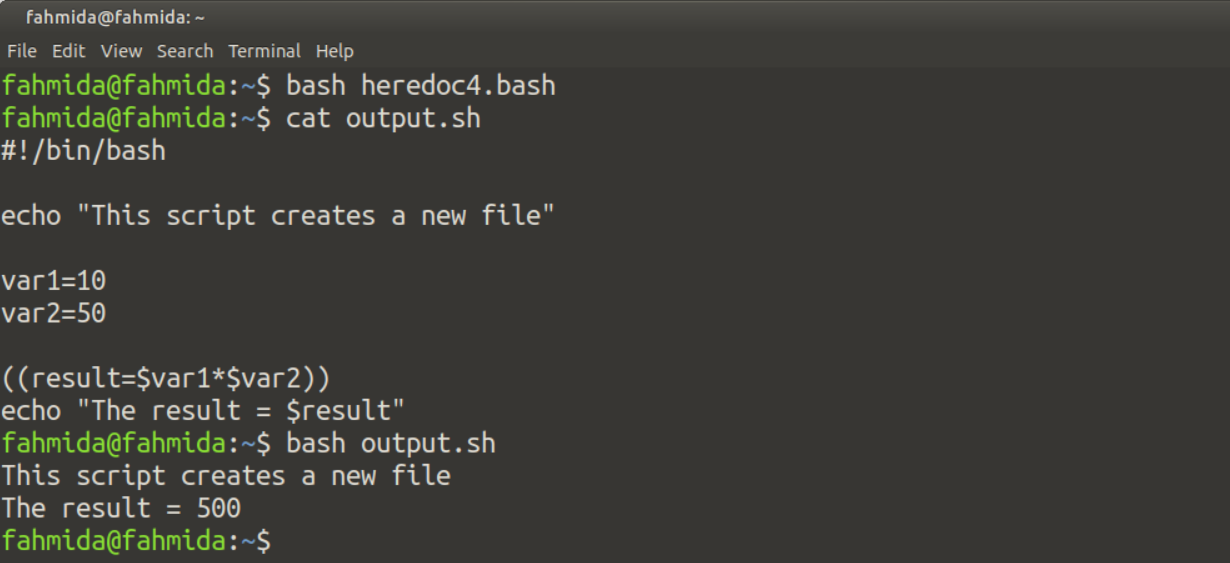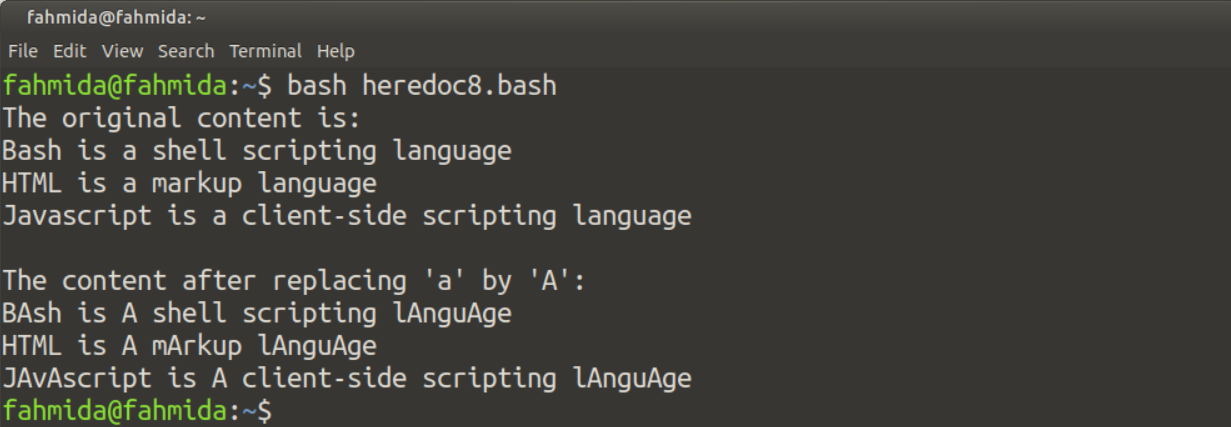To use here-document in any bash script, you have to use the symbol << followed by any delimiting identifier after any bash command and close the HereDoc by using the same delimiting identifier at the end of the text. The syntax of writing HereDoc is shown below.
. . .
. . .
HeredocDelimiter
Example-1: Use of Simple heredoc Text
When the heredoc is used in any script, it is necessary to keep the same name for the starting and ending delimiter. Suppose the command is `cat` and the heredoc delimiter is ADDTEXT. Create a bash script file named heredoc1.bash with the following code to check the simple use of heredoc.
cat <<ADDTEXT
This text is
added by Here Document
ADDTEXT
Run the following command to execute the script.
Output:
The following output will appear after executing the script.
Example-2: Use of heredoc with ‘-’ symbol
HereDoc uses the ‘–‘ symbol to suppress any tab space from each line of heredoc text. In the following example, tab space is added at the start of each line, and the ‘–‘ symbol is used before the starting delimiter. When the script executes, all tab spaces are omitted from the starting of each line, but it creates no effect on normal space. Create a bash file named heredoc2.bash with the following script to test the function of ‘–‘.
cat <<-ADDTEXT2
Line-1: Here Document is helpful to print short text
Line-2: Here Document can be used to format text
Line-3: Here Document can print variables within the text
Line-4: Here Document with '-' removes tab space from the line
ADDTEXT2
Run the following command to execute the script.
Output:
The following output will appear after executing the script. The tab space has been removed from the heredoc content.
Example-3: Use of Variable within heredoc Text
Create a new bash script with the following code. Here, two variables named start and end are declared. These variables are used within the heredoc text. If you use a quotation mark at the starting delimiter of heredoc, then the variable’s value will not print in the console.
start="Hello everybody"
end="Good Luck"
cat <<ADDTEXT3
$start
Welcome to Linux Blog Site.
$end
ADDTEXT3
Run the following command to execute the script.
Output:
The following output will appear after executing the script. The output shows the heredoc content with the value of the variables.
Example-4: Create a new bash file using HerDoc
In the previous examples, how you can use heredoc in any bash script are shown. You can also create a new bash file using heredoc, shown in the next part of this tutorial. Create a new bash file named heredoc4.sh with the following code. Here, the NewFile variable is declared to set the file name of the new bash script, which will be created after the execution of heredoc4.sh file. After the execution, a new bash file named output.sh will be created.
NewFile=output.sh
(
cat < $NewFile
Run the following commands to test the above script. The first command will execute the main script file. The second command will display the content of the newly created file. The third command will run the newly created bash file.
$ cat output.sh
$ bash output.sh
Output:
The following output will appear after executing the script.
Example-5: Using Function with heredoc
You can pass input values to the variables of any function of the bash script from heredoc content. Create another new bash file named heredoc5.sh to test how function can be used with heredoc. Add the following code to the file. A function named BookInfo is declared in the script, which will take data from heredoc text. Six variables are declared in the function named ISBN, bookName, authorName, edition, publication, and price. To set the value of the variables properly, you have to maintain the order of the values in the heredoc section according to the variables declared in the function. After setting the data in the function variables, the price value is calculated by a 10% discount and printed the values of all variables in the console.
#Declare the function which will retrieve data from Here Document
BookInfo ()
{
read ISBN
read bookName
read authorName
read edition
read publication
read price
}
# Declare here document part to send data into the function
BookInfo <<ADDTEXT5
ISBN-78633567809
Easy Laravel 5
W. Jason Gilmore
9th Edition
Learpub
100
ADDTEXT5
# Print the value of the function variables after calculating price value with 10% discount
((price=$price-$price*10/100))
echo "$bookName"
echo "$authorName"
echo "$edition, $publication"
echo "$"$price
Run the following command to execute the script.
Output:
Here, the value of the price variable has been set to 100. After setting a 10% discount on price value, the value has been set to 90. After the execution, the following output will appear in the terminal.
Example-6: Execute commands inside the heredoc
Create a bash file named heredoc6.bash with the following script to execute `date`, `pwd`, and `whoami` command with `sudo` command.
# Add three commands inside the heredoc content with the `sudo` command
sudo -s <<COMMAND
date
pwd
whoami
COMMAND
Output:
The following output will appear after executing the above script. The output of the three commands has printed in the output.
Example-7: Use of heredoc to write multiple lines into a file
Create a bash file named heredoc6.bash with the following script to add multiple lines in the text file named temp.txt and print the file’s content. Three lines will be added to the text file after executing the code.
: 'This script will write multiple lines
into a text file
'
# Write multiple lines into a file using heredoc
cat > 'temp.txt' <<FileContent
Bash is a popular scripting language.
Many administrative tasks can be done easily
by using bash script.
FileContent
# Print the content of the file
cat temp.txt
Output:
The following output will appear after executing the above script. The output shows that three lines are added in the temp.txt file.
Example-8: using heredoc with pipe to search and replace the content
The heredoc input can also be piped. Create a bash file with the following script to search and replace a particular character from the heredoc content. The first heredoc will print the original text, and the second heredoc will print the replaced text. The `sed` command has been used here to replace all instances of the character ‘a’ by ‘A’.
echo "The original content is:"
cat <<'ORIGINAL'
Bash is a shell scripting language
HTML is a markup language
Javascript is a client-side scripting language
ORIGINAL
# Add a newline
echo
echo "The content after replacing 'a' by 'A':"
cat <<'REPLACE' | sed 's/a/A/g'
Bash is a shell scripting language
HTML is a markup language
Javascript is a client-side scripting language
REPLACE
Output:
The following output will appear after executing the above script. In the output, all ‘a’ have been replaced by ‘A’.
Example-9: Use of heredoc to comment out the block of lines
One of the important use of heredoc is to comment on multiple lines of the bash script. Create a bash file with the following script to find a year is a leap year or not. The purpose of the script has been described by multi-line comments using heredoc.
<<multiline_comment
This script is used to find out
a year is a leap year or not a
leap year
multiline_comment
# Take 4-digit year value from the user
echo -n "Enter the four digit year value: "
read yr
# Check the taken year value is a leap or not a leap year
if [ $(($yr%400)) -eq 0 ]; then
echo "$yr is a Leap year."
elif [ $(($yr%100)) -eq 0 ]; then
echo "$yr is not a Leap year."
elif [ $(($yr%4)) -eq 0 ]; then
echo "$yr is a Leap year."
else
echo "$yr is not a leap year."
fi
Output:
The following output will appear after executing the above script. The following output shows that 2008 is a leap year and 2021 is not a leap year.
Conclusion:
The various uses of the heredoc document have shown in this tutorial by using multiple examples. It can be used with different types of shell commands and adding multi-line comments in the bash script. The uses of the heredoc will be cleared for the bash users after practicing the examples of this tutorial.









